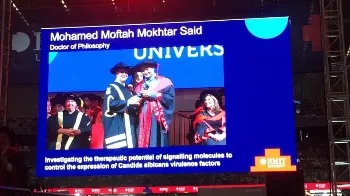محمد مفتاح المختار سعيد
رئيس قسم التقنيات الحيوية
عضو هيئة تدريس قار
المؤهل العلمي: دكتوراه
الدرجة العلمية: محاضر
التخصص: تقنيات حيوية - علوم حيوية
قسم علم التقنية الحيوية - كلية العلوم - الزنتان
المنشورات العلمية
Garlic alters the expression of putative virulence factor genes SIR2 and ECE1 in vulvovaginal C. albicans isolates
Journal ArticleVulvovaginal candidiasis causes sufferers much discomfort. Phytotherapy with garlic has been reported to be a possible alternative form of treatment; however, it is unknown why patients report varying success with this strategy. Fresh garlic extract has been shown to down-regulate the putative virulence gene, SIR2 in C. albicans. Our study aimed to see if previous observations were reproducible for the gene responsible for Candidalysin (ECE1). Two clinical strains from patients with reported variable efficacy of using garlic for the treatment of vulvovaginal candidiasis were compared through biofilm assays and antimicrobial susceptibility. Real-time PCR was used to assess changes in gene expression when exposed to garlic. Treatment with fresh garlic extract and pure allicin (an active compound produced in cut garlic) resulted in a decrease in SIR2 expression in all strains. In contrast, ECE1 expression was up-regulated in a reference strain and an isolate from a patient unresponsive to garlic therapy, while in an isolate from a patient responsive to garlic therapy, down-regulation of ECE1 occurred. future studies that investigate the effectiveness of phytotherapies should take into account possible varying responses of individual strains and that gene expression may be amplified in the presence of serum.
MOHAMED M. SAID, (02-2020), Nature: scientific reports, 10
High resolution melt analysis to track infections due to ribotype 027 Clostridium difficile
Journal ArticleThe increased prevalence of hypervirulent ribotype 027 Clostridium difficile requires rapid identification of iso lates in ordertoimplementtimelyinfectioncontrol strategies. Highresolution melt(HRM) analysisof PCRprod ucts can identify strain variation amongst genera of bacteria. The intergenic (16S–23S rDNA) spacer region contains sequenceregionsconserved withingeneraandothersequenceregionvariablesbetweenspecieswithin genera. Wewished toinvestigate whether HRM analysis of PCR ribotyping products could identify ribotype 027 C. difficile. Ribotyping was performed on 93 clinical isolates and five control strains and band patterns were ana lysedusingGelComparII(AppliedMaths,USA).Real-timePCRusingribotypingprimerswasperformedandnor malised melt curves were generated. The HRM data was then imported into ScreenClust software (QIAGEN) to generate principal component analysis graphs depicting clustered relationships of strains. Ribotyping produced clear PCR bands for 88/98 isolates tested. Dendrograms generated by GelCompar showed a diversity of ribotype patterns amongst these 88 isolates with 18 groups identified with 70% homology. One clinical isolate showed 100%homologywiththecontrol027strains. ScreenClustanalysisofthe same88HRMresultsshowedclustering of isolates, with 027 strains identifiable as a unique cluster. HRM analysis correctly identified the control 027 stains and the clinical isolate shown to be 027. HRM combined with ScreenClust analysis of real-time PCR prod ucts of the 16S–23S rDNA spacer region successfully identified ribotype 027 strains. For infection control pur poses this was achieved within 2–3 h of colony isolation.
MOHAMED MOFTAH MOKHTAR SAID, Mohamed M. Said, (03-2012), ScienceDirect: Journal of Microbiological Methods, 89

